Recent Advances in Click Chemistry Applied to Dendrimer Synthesis
Abstract
:1. Introduction
2. Click Reactions Applied to Dendrimers
2.1. Dendrimers
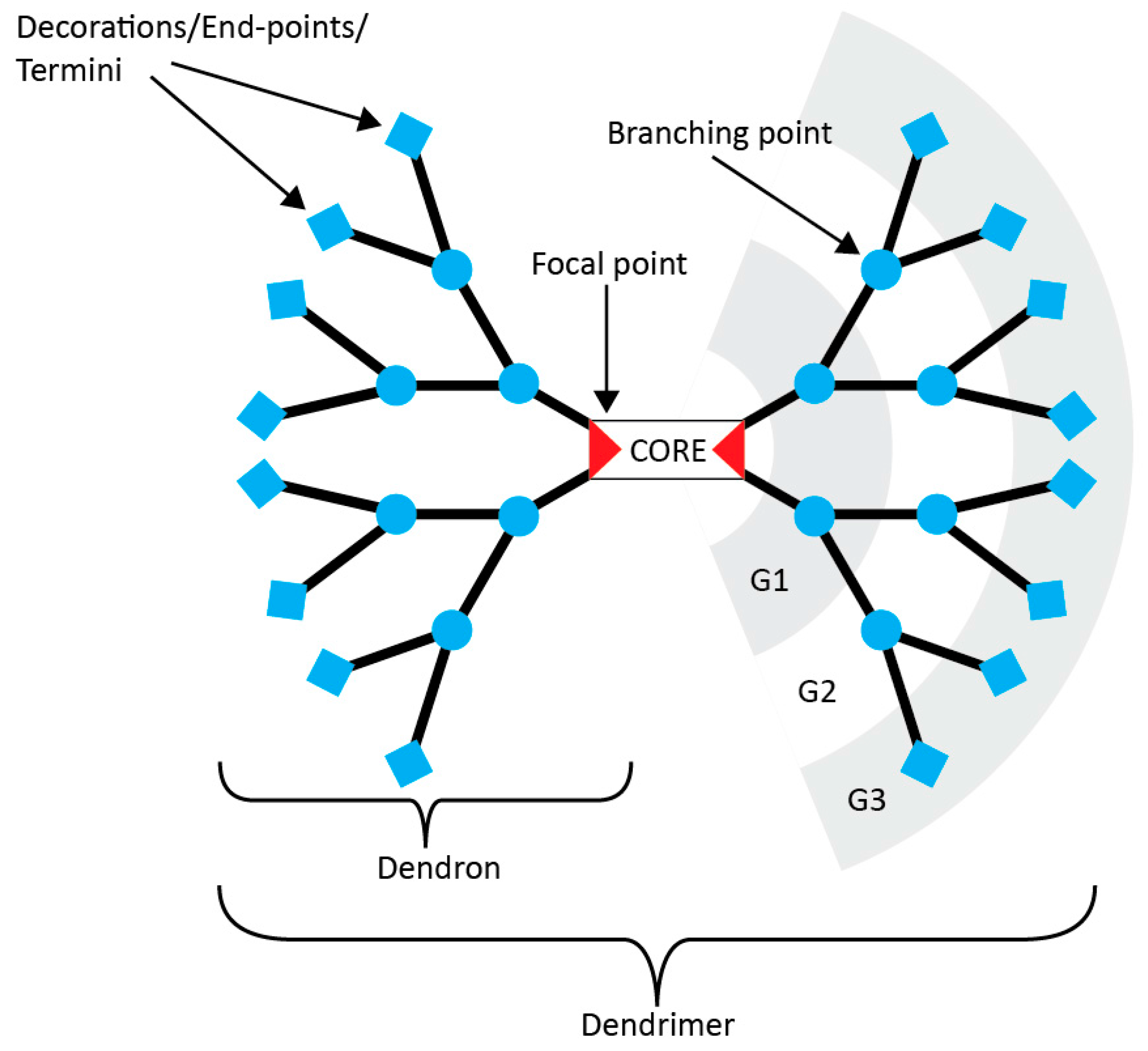
2.2. The Click Chemistry Paradigm Applied to Dendrimers
2.2.1. Copper-Assisted Azide-Alkyne Cycloaddition (CuAAC)
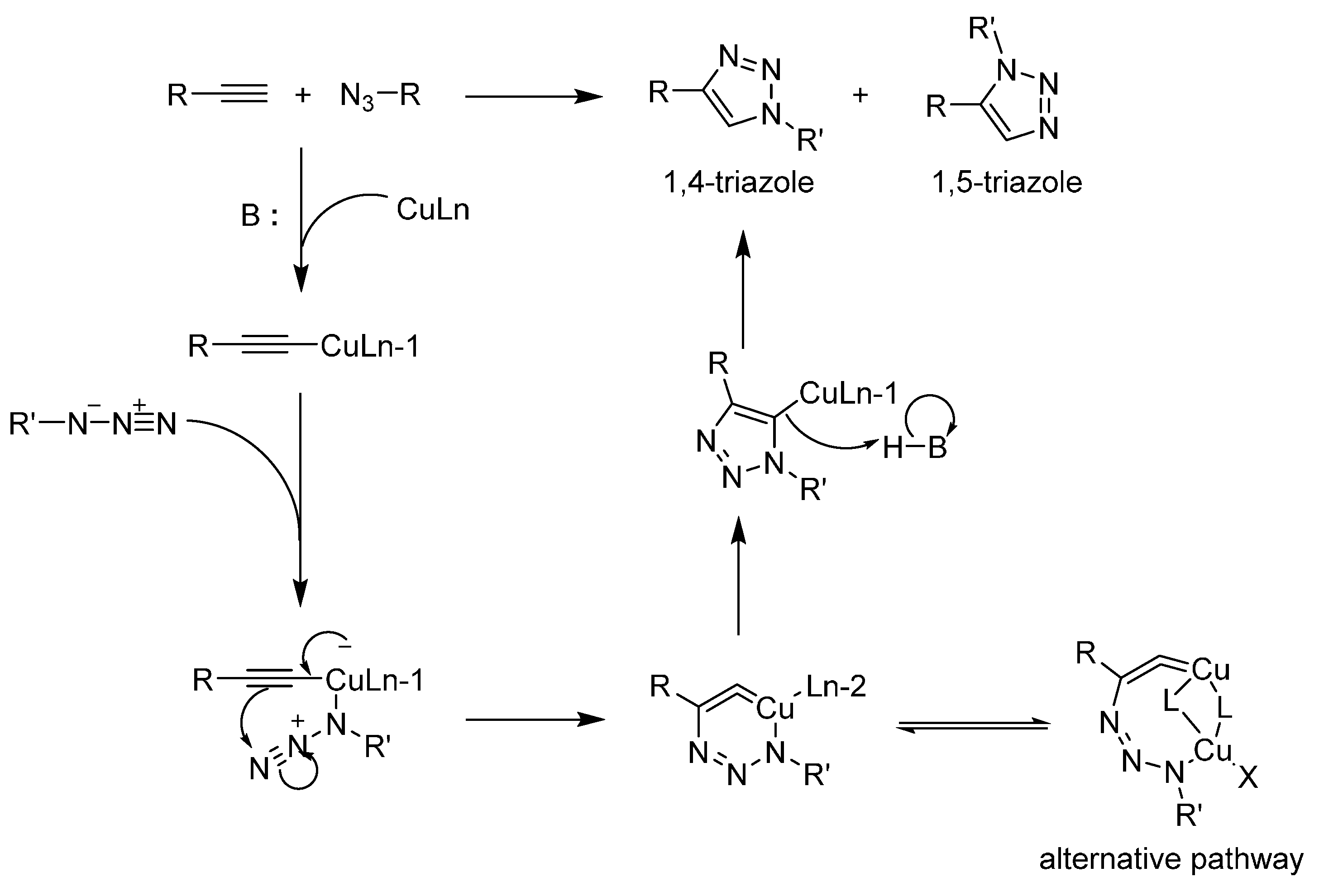
| Catalyst | Base/Acid/Reductant/Ligand | Solvent | Temp. | Type of Architecture | Typical Reference |
|---|---|---|---|---|---|
| CuSO4 | NaAsc, THPTA, TBTA, Ph-COOH, K2CO3, NaHCO3 | H2O, THF, DMF, t-BuOH a, EtOH a, MeOH a | rt, 50 °C, 85 °C b, MW | PAMAM, Fréchet-type, Percec-type, polyesters, PEG branches, polypeptides, others | [30,31,38,39,40] |
| CuOAc | NaAsc, THPTA, TBTA | DMF, MeOH | rt, 100 °C | Polypeptides, others | [39,41] |
| CuI | Et3N, DIPEA | DMF, THF, DCM | rt | PAMAM, polyesters, polypeptides, others | [40,42,43,44] |
| CuBr | PMEDTA | DMF, THF | rt, 40 °C | PEG-branches, others | [38,45,46] |
| CuF2 | - | MeOH, H2O | 40 °C | Polyesters | [40] |
| Cu(MeCN)4PF6 | DIPEA | MeOH, DCM | rt | Peptides | [47] |
| Metallic Cu | Et3NH4Ac | MeOH | MW (7h), 70 °C | Phosphocarbohydrates | [48,49] |
| Method | Comment | Typical Reference |
|---|---|---|
| NH4Cl sat. washes | This is a pH 5 solution that can be basified by adding NH4OH. We found that several washes were needed. | [44] |
| EDTA washes | Because of EDTA four pKa values, we observed a great variability of pH and efficiency, depending on the commercial version used. | [70] |
| KCN washes | Given the high toxicity of HCN, this solution needs to be kept basic until safely discarded. | [71] |
| Dialysis | This method is the longest and suits hydrophilic dendrimers that are unfit for aqueous/organic washes. Dilute EDTA can be added to the external solution. | [72,73] |
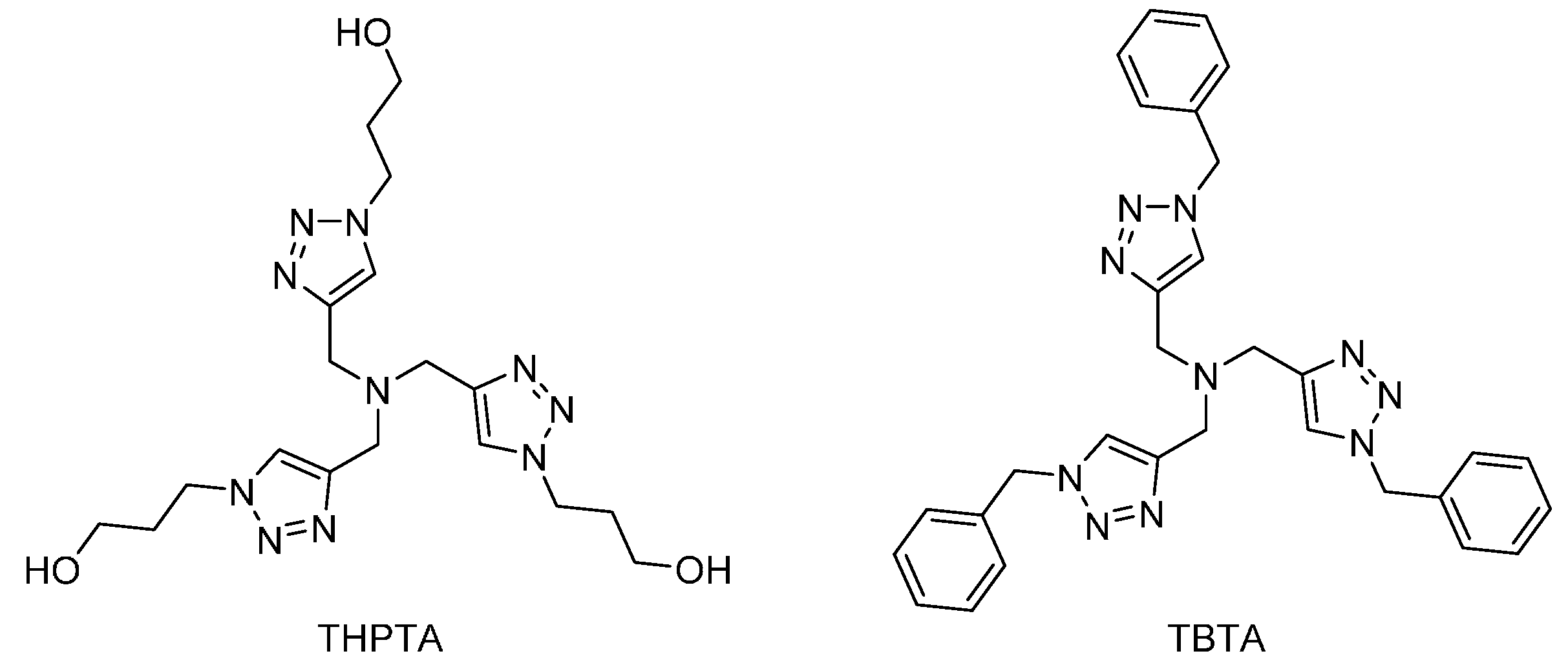
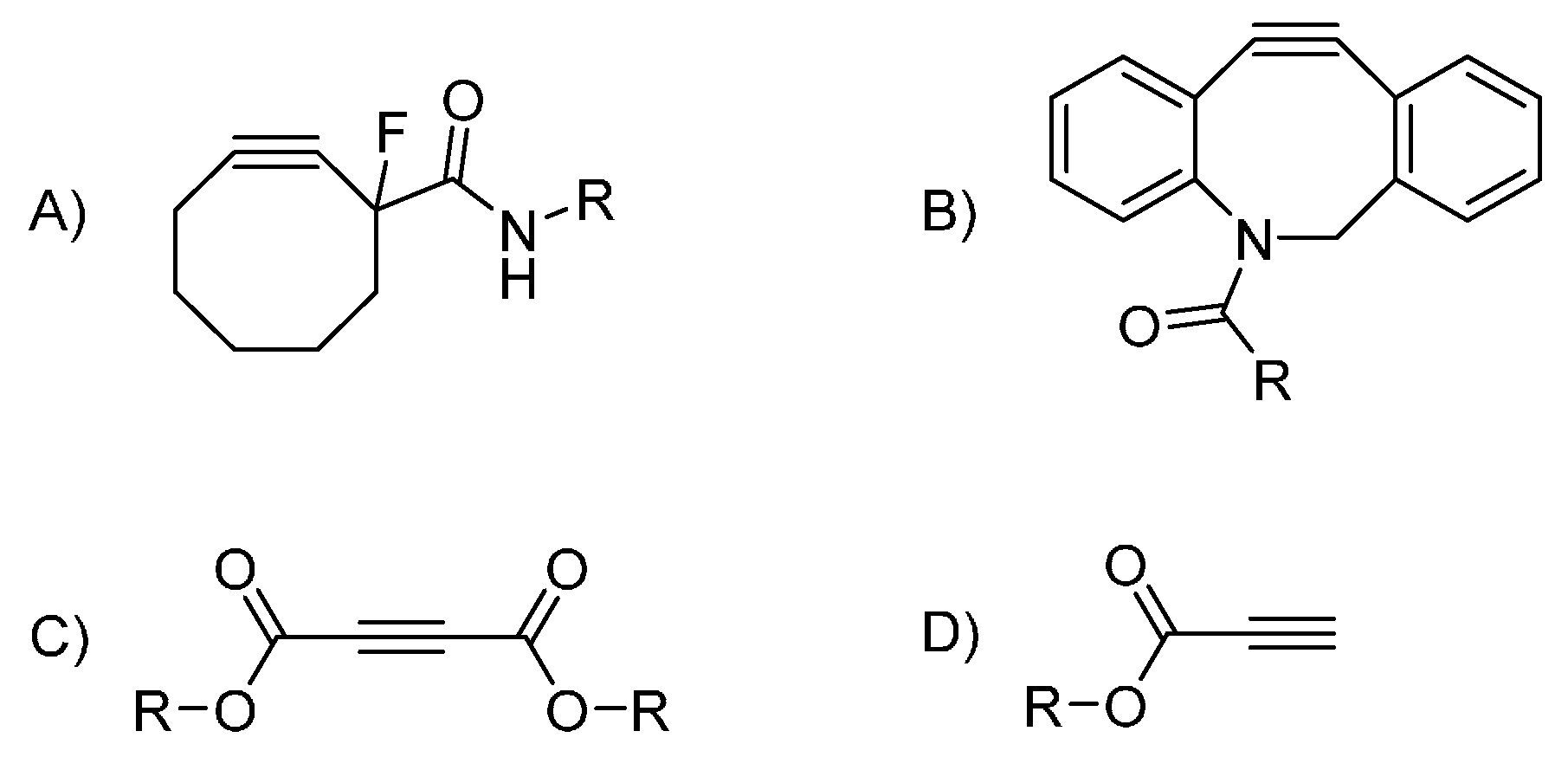
2.2.2. The Thiol-ene and Thiol-yne Click Reactions
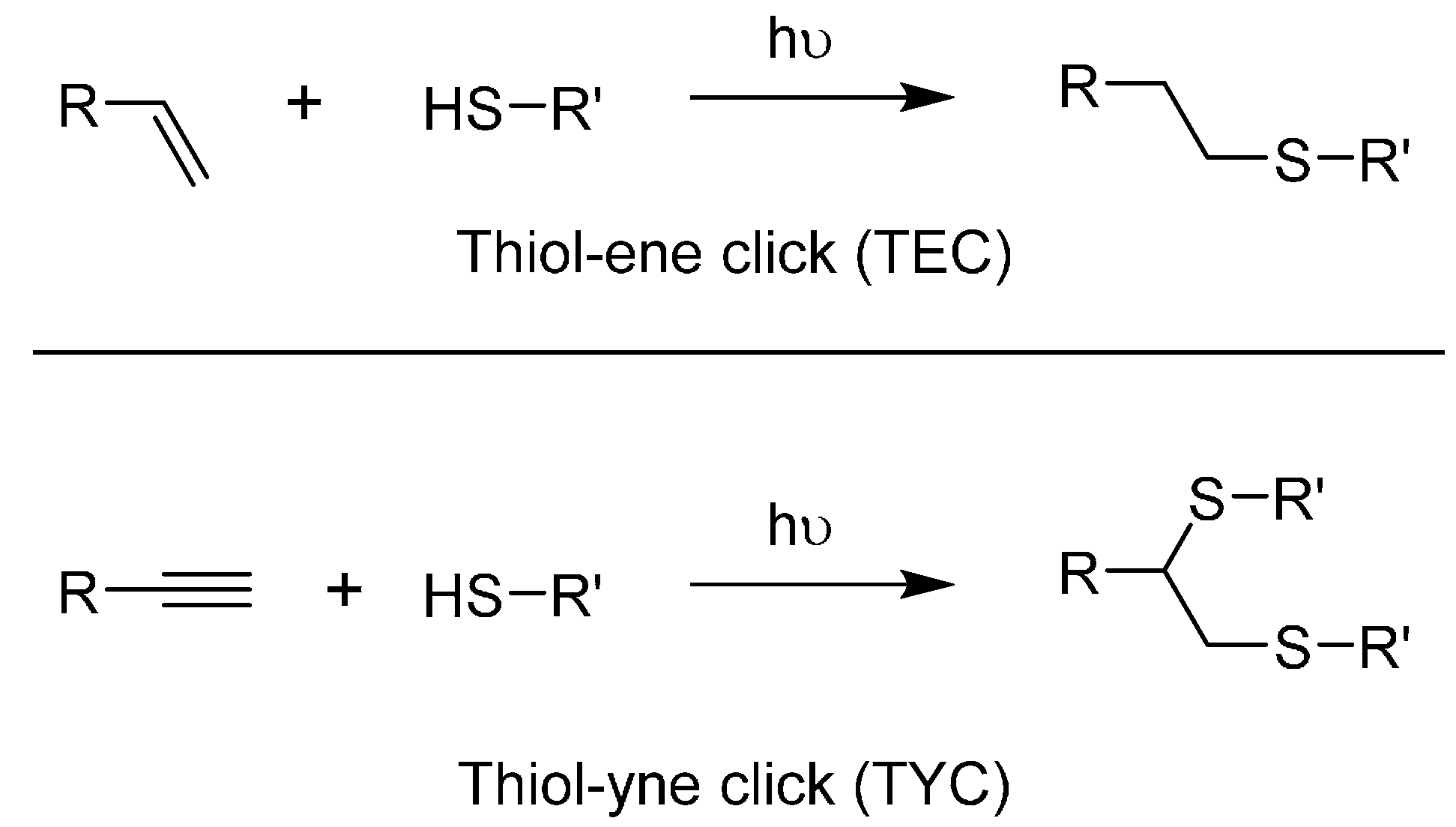
2.2.3. The Diels-Alder (DA) Reaction
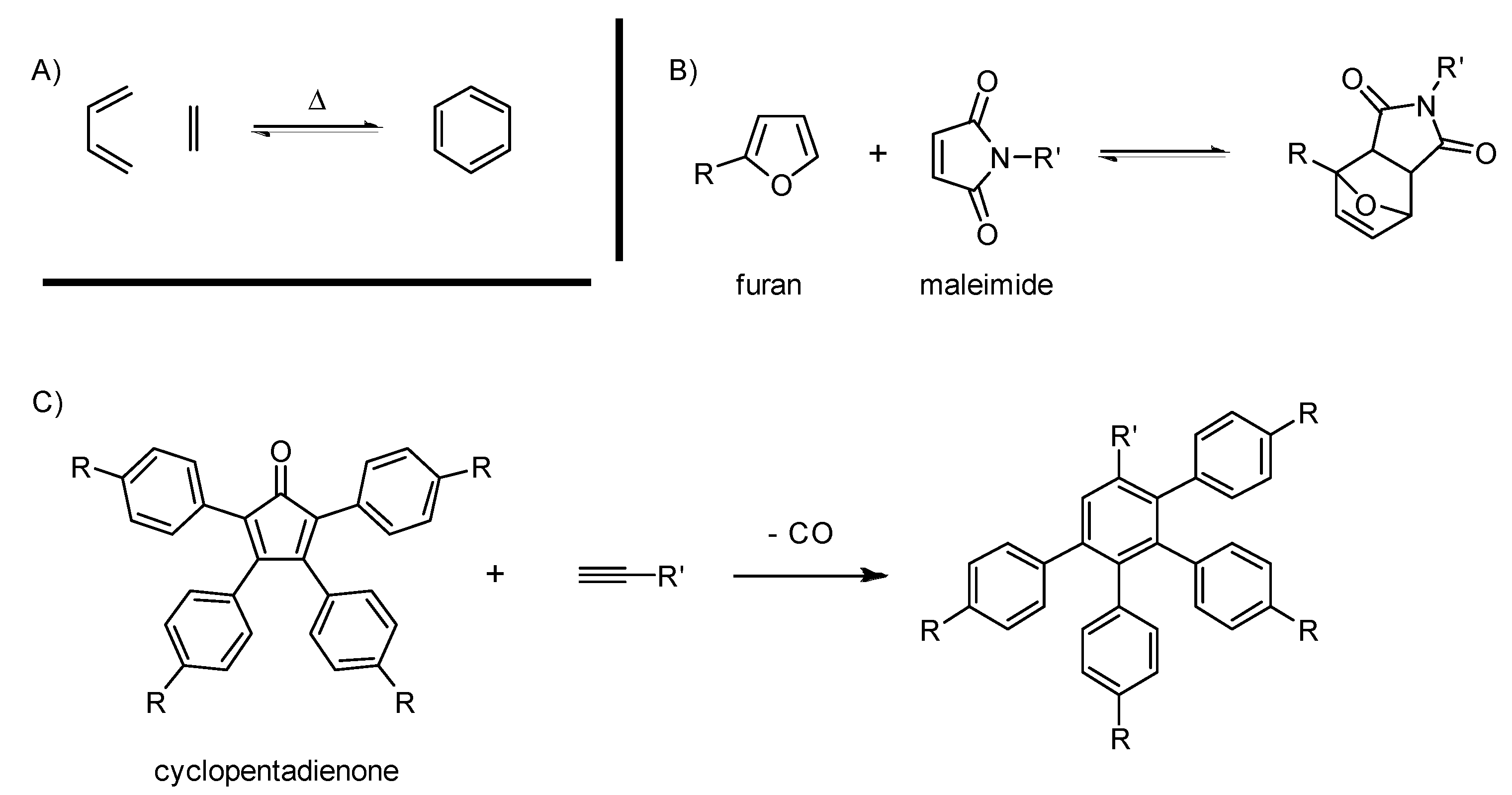
2.2.4. Upcoming Click Reactions for Dendrimers
3. Structural Advances
3.1. Rise of Complexity
3.1.1. Difficult Decorations and other High Molar Mass Dendrimers
3.1.2. Janus and Controlled 3-Face Dendrimers
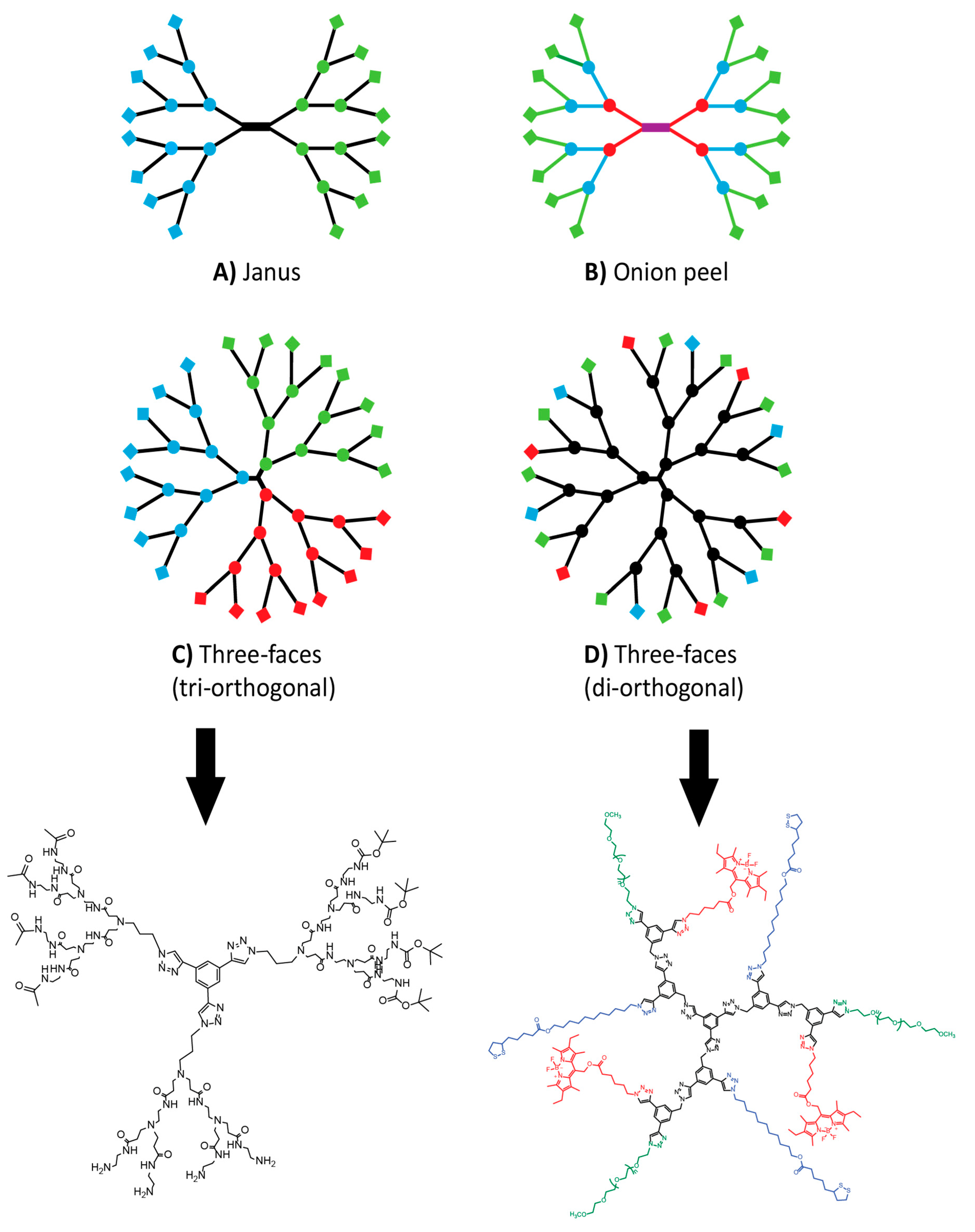
3.1.3. The “Core-Shell-Surface” and the “Onion Peel” Strategies
3.1.4. Advances in Dendronized Polymer Synthesis
3.1.5. Vesicles and Micelles
3.1.6. Degradable Dendrimers
3.1.7. Other Complex Assemblies
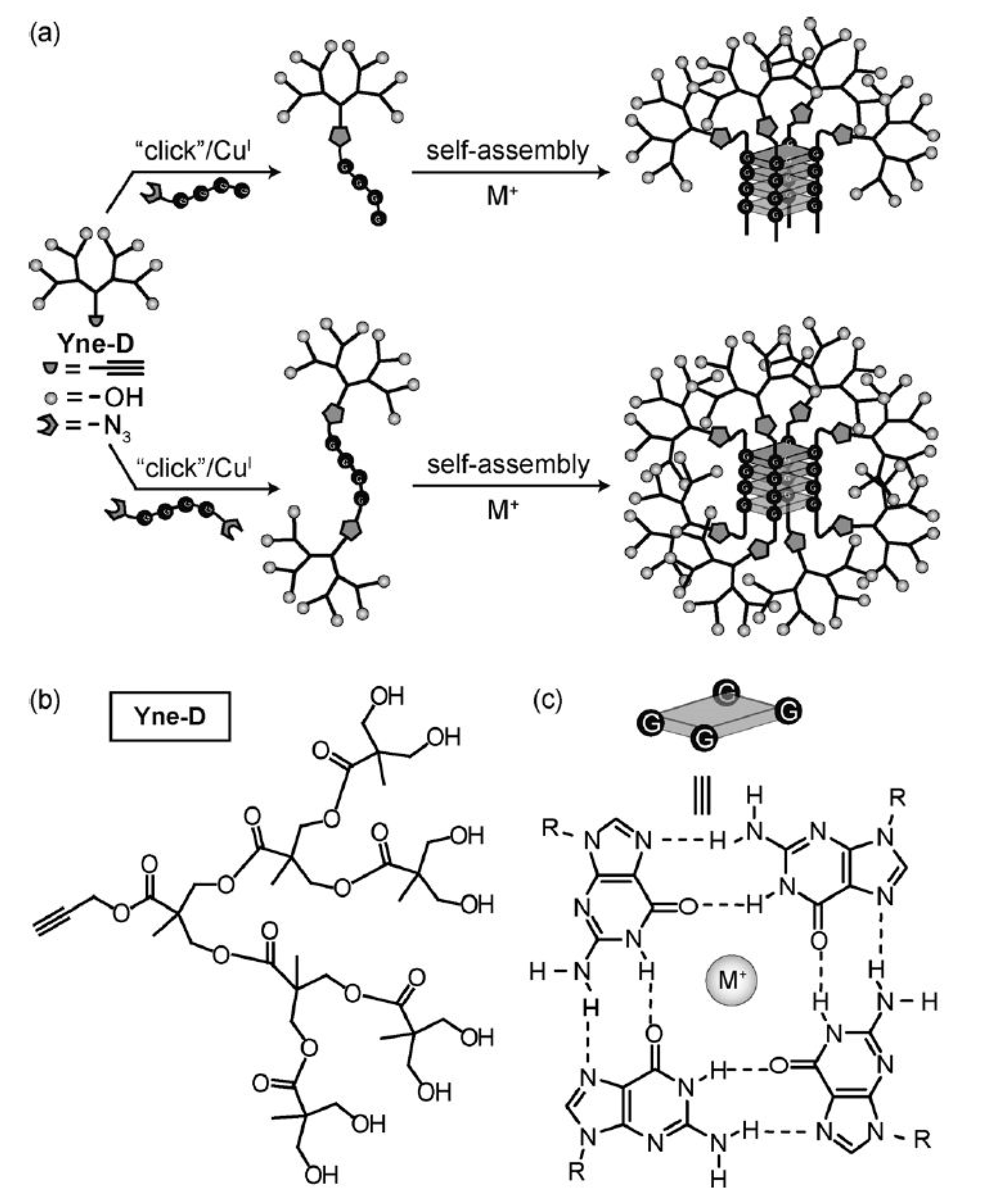
3.2. New Dendritic Architectures Featuring Click Chemistry
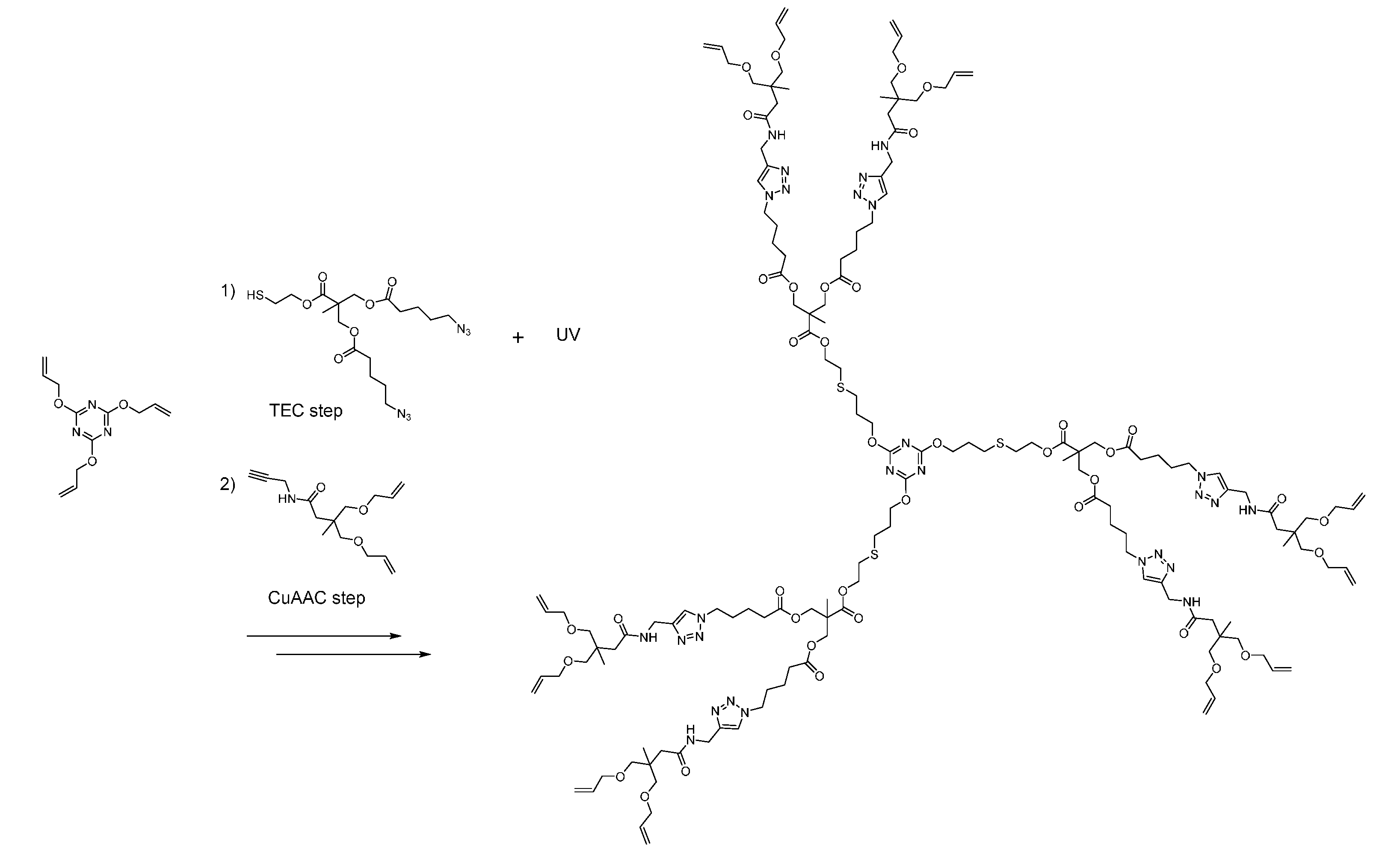

4. Conclusions
Acknowledgments
Conflicts of Interest
References and Notes
- Kolb, H.C.; Finn, M.G.; Sharpless, K.B. Click Chemistry: Diverse Chemical Function from a Few Good Reactions. Angew. Chem. Int. Ed. 2001, 40, 2004–2021. [Google Scholar] [CrossRef]
- Wu, P.; Feldman, A.K.; Nugent, A.K.; Hawker, C.J.; Scheel, A.; Voit, B.; Pyun, J.; Fréchet, J.M.J.; Sharpless, K.B.; Fokin, V.V. Efficiency and Fidelity in a Click-Chemistry Route to Triazole Dendrimers by the Copper(I)-Catalyzed Ligation of Azides and Alkynes. Angew. Chem. Int. Ed. 2004, 43, 3928–3932. [Google Scholar] [CrossRef]
- Franc, G.; Kakkar, A.K. “Click” methodologies: Efficient, simple and greener routes to design dendrimers. Chem. Soc. Rev. 2010, 39, 1536–1544. [Google Scholar] [CrossRef] [PubMed]
- Gao, C.; Yan, D. Hyperbranched polymers: From synthesis to applications. Prog. Polym. Sci. 2004, 29, 183–275. [Google Scholar] [CrossRef]
- Qin, A.; Lam, J.W.Y.; Tang, B.Z. Click polymerization. Chem. Soc. Rev. 2010, 39, 2522–2544. [Google Scholar] [CrossRef] [PubMed]
- Hadjichristidis, N.; Pitsikalis, M.; Pispas, S.; Iatrou, H. Polymers with Complex Architecture by Living Anionic Polymerization. Chem. Rev. 2001, 101, 3747–3792. [Google Scholar] [CrossRef] [PubMed]
- Tomalia, D.A.; Baker, H.; Dewald, J.; Hall, M.; Kallos, G.; Martin, S.; Roeck, J.; Ryder, J.; Smith, P. A New Class of Polymers: Starburst-Dendritic Macromolecules. Polym. J. 1985, 17, 117–132. [Google Scholar] [CrossRef]
- Klajnert, B.; Peng, L.; Cena, V. Dendrimers in Biomedical Applications; Royal Society of Chemistry: Cambridge, UK, 2013; p. 204. [Google Scholar]
- Tomalia, D.A.; Fréchet, J.M.J. Dendrimers and Other Dendritic Polymers; John Wiley & Sons: New York, NY, USA, 2002. [Google Scholar]
- Shcharbin, D.; Klajnert, B.; Bryszewska, M. Practical Guide to Studying Dendrimers, 1st ed.; iSmithers Rapra Publishing: Shawbury, UK, 2010. [Google Scholar]
- Mintzer, M.A.; Grinstaff, M.W. Biomedical applications of dendrimers: a tutorial. Chem. Soc. Rev. 2011, 40, 173–190. [Google Scholar] [CrossRef] [PubMed]
- McNerny, D.Q.; Mullen, D.G.; Majoros, I.J.; Banaszak Holl, M.M.; Baker, J.R. Dendrimer Synthesis and Functionalization by Click Chemistry for Biomedical Applications. In Click Chemistry for Biotechnology and Materials Science; John Wiley & Sons: New York City, NY, USA, 2009; pp. 177–193. [Google Scholar]
- Cheng, Y.; Zhao, L.; Li, Y.; Xu, T. Design of biocompatible dendrimers for cancer diagnosis and therapy: Current status and future perspectives. Chem. Soc. Rev. 2011, 40, 2673–2703. [Google Scholar] [CrossRef] [PubMed]
- Balzani, V.; Campagna, S.; Denti, G.; Juris, A.; Serroni, S.; Venturi, M. Designing Dendrimers Based on Transition-Metal Complexes. Light-Harvesting Properties and Predetermined Redox Patterns. Acc. Chem. Res. 1998, 31, 26–34. [Google Scholar]
- Adronov, A.; Frechet, J.M.J. Light-harvesting dendrimers. Chem. Commun. 2000, 1701–1710. [Google Scholar] [CrossRef]
- Wang, D.; Astruc, D. Dendritic catalysis—Basic concepts and recent trends. Coord. Chem. Rev. 2013, 257, 2317–2334. [Google Scholar] [CrossRef]
- McCarthy, T.D.; Karellas, P.; Henderson, S.A.; Giannis, M.; O’Keefe, D.F.; Heery, G.; Paull, J.R.A.; Matthews, B.R.; Holan, G. Dendrimers as Drugs: Discovery and Preclinical and Clinical Development of Dendrimer-Based Microbicides for HIV and STI Prevention. Mol. Pharm. 2005, 2, 312–318. [Google Scholar] [CrossRef] [PubMed]
- With a known conversiosn percentage for a given reaction, one can obtain the percentage of “perfect” dendrimer for a given generation (divergent method). This simplified formula does not account for purification steps or the de Gennes packing effects. First, the total number of time the reaction has been done (Y) must be calculated. For this, we sum the number of surface groups given by the formula of Tomalia et al., where Nc is the core multiplicity, Nb is the branch cell multiplicity and G stands for the generation. From this, with a known conversion rate (m), one can calculate the percentage of defect-free dendrimer (x) with formula 2: confirm the format As an example, for a G6 PAMAM, with a m of 95%, we obtain 2 × 10–4% of the desired dendrimer, while a 99% conversion gives 8%. Details of this work are available upon request.
- Xi, W.; Scott, T.F.; Kloxin, C.J.; Bowman, C.N. Click Chemistry in Materials Science. Adv. Funct. Mater. 2014, 24, 2572–2590. [Google Scholar] [CrossRef]
- Iha, R.K.; Wooley, K.L.; Nyström, A.M.; Burke, D.J.; Kade, M.J.; Hawker, C.J. Applications of Orthogonal “Click” Chemistries in the Synthesis of Functional Soft Materials. Chem. Rev. 2009, 109, 5620–5686. [Google Scholar] [CrossRef] [PubMed]
- Such, G.K.; Johnston, A.P.R.; Liang, K.; Caruso, F. Synthesis and functionalization of nanoengineered materials using click chemistry. Prog. Polym. Sci. 2012, 37, 985–1003. [Google Scholar] [CrossRef]
- Rostovtsev, V.V.; Green, L.G.; Fokin, V.V.; Sharpless, K.B. A Stepwise Huisgen Cycloaddition Process: Copper(I)-Catalyzed Regioselective “Ligation” of Azides and Terminal Alkynes. Angew. Chem. Int. Ed. 2002, 41, 2596–2599. [Google Scholar] [CrossRef]
- Spiteri, C.; Moses, J.E. Copper-Catalyzed Azide-Alkyne Cycloaddition: Regioselective Synthesis of 1,4,5-Trisubstituted 1,2,3-Triazoles. Angew. Chem. Int. Ed. 2010, 49, 31–33. [Google Scholar] [CrossRef]
- Bock, V.D.; Hiemstra, H.; van Maarseveen, J.H. CuI-Catalyzed Alkyne–Azide “Click” Cycloadditions from a Mechanistic and Synthetic Perspective. Eur. J. Org. Chem. 2006, 2006, 51–68. [Google Scholar] [CrossRef]
- Berg, R.; Straub, B.F. Advancements in the mechanistic understanding of the copper-catalyzed azide-alkyne cycloaddition. Beilstein J. Org. Chem. 2013, 9, 2715–2750. [Google Scholar] [CrossRef] [PubMed]
- Hein, J.E.; Fokin, V.V. Copper-catalyzed azide-alkyne cycloaddition (CuAAC) and beyond: New reactivity of copper(I) acetylides. Chem. Soc. Rev. 2010, 39, 1302–1315. [Google Scholar] [CrossRef] [PubMed]
- Arseneault, M.; Dufour, P.; Levesque, I.; Morin, J.-F. Synthesis of a controlled three-faced PAMAM particle. Polym. Chem. 2011, 2, 2293–2298. [Google Scholar] [CrossRef]
- Han, S.C.; Kim, J.H.; Lee, J.W. Convergent synthesis of PAMAM dendrimers containing tetra(ethylene oxide) at core using click chemistry. Bull. Korean Chem. Soc. 2012, 33, 3501–3504. [Google Scholar] [CrossRef]
- Papadopoulos, A.; Shiao, T.C.; Roy, R. Diazo transfer and Click chemistry in the solid phase syntheses of lysine-based glycodendrimers as antagonists against Escherichia coli FimH. Mol. Pharm. 2012, 9, 394–403. [Google Scholar] [CrossRef] [PubMed]
- Yim, C.-B.; Dijkgraaf, I.; Merkx, R.; Versluis, C.; Eek, A.; Mulder, G.E.; Rijkers, D.T.S.; Boerman, O.C.; Liskamp, R.M.J. Synthesis of DOTA-Conjugated Multimeric [Tyr3]Octreotide Peptides via a Combination of Cu(I)-Catalyzed “Click” Cycloaddition and Thio Acid/Sulfonyl Azide “Sulfo-Click” Amidation and Their in Vivo Evaluation. J. Med. Chem. 2010, 53, 3944–3953. [Google Scholar] [CrossRef] [PubMed]
- Gatard, S.; Liang, L.; Salmon, L.; Ruiz, J.; Astruc, D.; Bouquillon, S. Water-soluble glycodendrimers: Synthesis and stabilization of catalytically active Pd and Pt nanoparticles. Tetrahedron Lett. 2011, 52, 1842–1846. [Google Scholar] [CrossRef]
- Elias, D.R.; Cheng, Z.; Tsourkas, A. An Intein-Mediated Site-Specific Click Conjugation Strategy for Improved Tumor Targeting of Nanoparticle Systems. Small 2010, 6, 2460–2468. [Google Scholar] [CrossRef] [PubMed]
- Han, S.C.; Yoon, J.; Oh, J.; Lee, J.W. Synthesis of [3]-rotaxane dendrimers by host-mediated click chemistry. Bull. Korean Chem. Soc. 2011, 32, 3809–3812. [Google Scholar] [CrossRef]
- Han, S.C.; Choi, I.-H.; Jin, S.-H.; Lee, J.W. Efficient Synthesis of Carbazole Core Diblock Dendrimer by Double Click Chemistry. Mol. Cryst. Liquid Cryst. 2014, 599, 86–95. [Google Scholar] [CrossRef]
- Rodionov, V.O.; Fokin, V.V.; Finn, M.G. Mechanism of the Ligand-Free CuI-Catalyzed Azide-Alkyne Cycloaddition Reaction. Angew. Chem. Int. Ed. 2005, 44, 2210–2215. [Google Scholar] [CrossRef]
- Siemsen, P.; Livingston, R.C.; Diederich, F. Acetylenic Coupling: A Powerful Tool in Molecular Construction. Angew. Chem. Int. Ed. 2000, 39, 2632–2657. [Google Scholar] [CrossRef]
- Meldal, M.; Tornøe, C.W. Cu-Catalyzed Azide−Alkyne Cycloaddition. Chem. Rev. 2008, 108, 2952–3015. [Google Scholar] [CrossRef] [PubMed]
- Wu, W.; Yu, G.; Liu, Y.; Ye, C.; Qin, J.; Li, Z. Using two simple methods of Ar-ArF self-assembly and isolation chromophores to further improve the comprehensive performance of NLO dendrimers. Chem. Eur. J. 2013, 19, 630–641. [Google Scholar] [CrossRef] [PubMed]
- Chamorro, C.; Boerman, M.A.; Arnusch, C.J.; Breukink, E.; Pieters, R.J. Enhancing membrane disruption by targeting and multivalent presentation of antimicrobial peptides. Biochim. Biophys. Acta 2012, 1818, 2171–2174. [Google Scholar] [CrossRef] [PubMed]
- Ledin, P.A.; Friscourt, F.; Guo, J.; Boons, G.-J. Convergent Assembly and Surface Modification of Multifunctional Dendrimers by Three Consecutive Click Reactions. Chem. Eur. J. 2011, 17, 839–846. [Google Scholar] [CrossRef] [PubMed]
- Liu, T.; Oukacine, F.; Collet, H.; Commeyras, A.; Vial, L.; Cottet, H. Monitoring surface functionalization of dendrigraft poly-l-lysines via click chemistry by capillary electrophoresis and Taylor dispersion analysis. J. Chromatogr. A 2013, 1273, 111–116. [Google Scholar] [CrossRef] [PubMed]
- Lee, J.W.; Han, S.C.; Yun, S.-H.; Jin, S.-H. Convergent synthesis of carbazole core PAMAM dendrimer via click chemistry. Bull. Korean Chem. Soc. 2013, 34, 971–974. [Google Scholar] [CrossRef]
- Kainz, Q.M.; Schaetz, A.; Zoepfl, A.; Stark, W.J.; Reiser, O. Combined Covalent and Noncovalent Functionalization of Nanomagnetic Carbon Surfaces with Dendrimers and BODIPY Fluorescent Dye. Chem. Mater. 2011, 23, 3606–3613. [Google Scholar] [CrossRef]
- Haridas, V.; Sharma, Y.K.; Sahu, S.; Verma, R.P.; Sadanandan, S.; Kacheshwar, B.G. Designer peptide dendrimers using click reaction. Tetrahedron 2011, 67, 1873–1884. [Google Scholar] [CrossRef]
- Gupta, S.; Schade, B.; Kumar, S.; Boettcher, C.; Sharma, S.K.; Haag, R. Non-ionic dendronized multiamphiphilic polymers as nanocarriers for biomedical applications. Small 2013, 9, 894–904. [Google Scholar] [CrossRef] [PubMed]
- Li, Z.A.; Wu, W.; Li, Q.; Yu, G.; Xiao, L.; Liu, Y.; Ye, C.; Qin, J.; Li, Z. High-Generation Second-Order Nonlinear Optical (NLO) Dendrimers: Convenient Synthesis by Click Chemistry and the Increasing Trend of NLO Effects. Angew. Chem. Int. Ed. 2010, 49, 2763–2767. [Google Scholar] [CrossRef]
- Peschko, K.; Schade, A.; Vollrath, S.B.L.; Schwarz, U.; Luy, B.; Muhle-Goll, C.; Weis, P.; Braese, S. Dendrimer-Type Peptoid-Decorated Hexaphenylxylenes and Tetraphenylmethanes: Synthesis and Structure in Solution and in the Gas Phase. Chem. Eur. J. 2014, 20, 16273–16278. [Google Scholar] [CrossRef] [PubMed]
- Skwarczynski, M.; Zaman, M.; Urbani, C.N.; Lin, I.C.; Jia, Z.; Batzloff, M.R.; Good, M.F.; Monteiro, M.J.; Toth, I. Polyacrylate Dendrimer Nanoparticles: A Self-Adjuvanting Vaccine Delivery System. Angew. Chem. Int. Ed. 2010, 49, 5742–5745. [Google Scholar] [CrossRef]
- Pourceau, G.; Meyer, A.; Chevolot, Y.; Souteyrand, E.; Vasseur, J.-J.; Morvan, F. Oligonucleotide Carbohydrate-Centered Galactosyl Cluster Conjugates Synthesized by Click and Phosphoramidite Chemistries. Bioconjugate Chem. 2010, 21, 1520–1529. [Google Scholar] [CrossRef]
- Lal, S.; Díez-González, S. [CuBr(PPh3)3] for Azide−Alkyne Cycloaddition Reactions under Strict Click Conditions. J. Org. Chem. 2011, 76, 2367–2373. [Google Scholar] [CrossRef] [PubMed]
- Worrell, B.T.; Malik, J.A.; Fokin, V.V. Direct Evidence of a Dinuclear Copper Intermediate in Cu(I)-Catalyzed Azide-Alkyne Cycloadditions. Science 2013, 340, 457–460. [Google Scholar] [CrossRef] [PubMed]
- Chen, H.-B.; Abeyrathna, N.; Liao, Y. Alkyne–azide cycloaddition catalyzed by a dinuclear copper(I) complex. Tetrahedron Lett. 2014, 55, 6575–6576. [Google Scholar] [CrossRef]
- Iacobucci, C.; Reale, S.; Gal, J.-F.; de Angelis, F. Dinuclear Copper Intermediates in Copper(I)-Catalyzed Azide-Alkyne Cycloaddition Directly Observed by Electrospray Ionization Mass Spectrometry. Angew. Chem. Int. Ed. 2015, 54, 3065–3068. [Google Scholar] [CrossRef]
- Liang, L.; Ruiz, J.; Astruc, D. The Efficient Copper(I) (Hexabenzyl)tren Catalyst and Dendritic Analogues for Green “Click” Reactions between Azides and Alkynes in Organic Solvent and in Water: Positive Dendritic Effects and Monometallic Mechanism. Adv. Synth. Catal. 2011, 353, 3434–3450. [Google Scholar] [CrossRef]
- Shao, C.; Wang, X.; Xu, J.; Zhao, J.; Zhang, Q.; Hu, Y. Carboxylic Acid-Promoted Copper(I)-Catalyzed Azide-Alkyne Cycloaddition. J. Org. Chem. 2010, 75, 7002–7005. [Google Scholar] [CrossRef] [PubMed]
- Soto-Castro, D.; Magana-Vergara, N.E.; Farfan, N.; Santillan, R. Synthesis of steroidal dendrimers modified by “click” chemistry with PAMAM dendrons as unimolecular micelles. Tetrahedron Lett. 2014, 55, 1014–1019. [Google Scholar] [CrossRef]
- Huisgen, R. 1,3-Dipolar Cycloadditions. Past and Future. Angew. Chem. Int. Ed. 1963, 2, 565–598. [Google Scholar] [CrossRef]
- Boren, B.C.; Narayan, S.; Rasmussen, L.K.; Zhang, L.; Zhao, H.; Lin, Z.; Jia, G.; Fokin, V.V. Ruthenium-Catalyzed Azide-Alkyne Cycloaddition: Scope and Mechanism. J. Am. Chem. Soc. 2008, 130, 8923–8930. [Google Scholar] [CrossRef] [PubMed]
- Han, S.C.; Kwak, S.H.; Jin, S.-H.; Lee, J.W. Synthesis of unsymmetrical Frechet-type dendrimers via double click chemistry. Bull. Korean Chem. Soc. 2012, 33, 1393–1396. [Google Scholar] [CrossRef]
- Luo, K.; Li, C.; Li, L.; She, W.; Wang, G.; Gu, Z. Arginine functionalized peptide dendrimers as potential gene delivery vehicles. Biomaterials 2012, 33, 4917–4927. [Google Scholar] [CrossRef] [PubMed]
- Kappe, C.O.; Van der Eycken, E. Click chemistry under non-classical reaction conditions. Chem. Soc. Rev. 2010, 39, 1280–1290. [Google Scholar] [CrossRef] [PubMed]
- Lee, C.Y.; Held, R.; Sharma, A.; Baral, R.; Nanah, C.; Dumas, D.; Jenkins, S.; Upadhaya, S.; Du, W. Copper-Granule-Catalyzed Microwave-Assisted Click Synthesis of Polyphenol Dendrimers. J. Org. Chem. 2013, 78, 11221–11228. [Google Scholar] [CrossRef] [PubMed]
- Barge, A.; Caporaso, M.; Cravotto, G.; Martina, K.; Tosco, P.; Aime, S.; Carrera, C.; Gianolio, E.; Pariani, G.; Corpillo, D. Design and Synthesis of a γ1β8-Cyclodextrin Oligomer: A New Platform with Potential Application as a Dendrimeric Multi-carrier. Chem. Eur. J. 2013, 19, 12086–12092. [Google Scholar] [CrossRef] [PubMed]
- Cendret, V.; Francois-Heude, M.; Mendez-Ardoy, A.; Moreau, V.; Garcia Fernandez, J.M.; Djedaini-Pilard, F. Design and synthesis of a “click” high-mannose oligosaccharide mimic emulating Man8 binding affinity towards Con A. Chem. Commun. 2012, 48, 3733–3735. [Google Scholar] [CrossRef]
- Ottaviani, M.F.; Bossmann, S.; Turro, N.J.; Tomalia, D.A. Characterization of starburst dendrimers by the EPR technique. 1. Copper complexes in water solution. J. Am. Chem. Soc. 1994, 116, 661–671. [Google Scholar]
- Diallo, M.S.; Balogh, L.; Shafagati, A.; Johnson, J.H.; Goddard, W.A.; Tomalia, D.A. Poly(amidoamine) Dendrimers: A New Class of High Capacity Chelating Agents for Cu(II) Ions. Environ. Sci. Technol. 1999, 33, 820–824. [Google Scholar] [CrossRef]
- Wan, X.J.; Xu, J.; Liu, S.Y. Facile synthesis of dendrimer-like star-branched poly(isopropylacrylamide) via combination of click chemistry and atom transfer radical polymerization. Sci. China: Chem. 2010, 53, 2520–2527. [Google Scholar] [CrossRef]
- Brewer, G.J. Copper toxicity in the general population. Clin. Neurophysiol. 2009, 121, 459–460. [Google Scholar] [CrossRef]
- Tan, S.S.; Kim, S.J.; Kool, E.T. Differentiating between Fluorescence-Quenching Metal Ions with Polyfluorophore Sensors Built on a DNA Backbone. J. Am. Chem. Soc. 2011, 133, 2664–2671. [Google Scholar] [CrossRef] [PubMed]
- Lang, H; Chandler, B.D. Dendrimer templates for supported nanoparticle catalysts. In Nanotechnology in Catalysis; Springer-Verlag: New York, NY, USA, 2007; Volume 3, pp. 91–113. [Google Scholar]
- Fedeli, E.; Lancelot, A.; Serrano, J.L.; Calvo, P.; Sierra, T. Self-assembling amphiphilic Janus dendrimers: mesomorphic properties and aggregation in water. New J. Chem. 2015, 39, 1960–1967. [Google Scholar] [CrossRef]
- Kecskes, A.; Tosh, D.K.; Wei, Q.; Gao, Z.-G.; Jacobson, K.A. GPCR Ligand Dendrimer (GLiDe) Conjugates: Adenosine Receptor Interactions of a Series of Multivalent Xanthine Antagonists. Bioconjugate Chem. 2011, 22, 1115–1127. [Google Scholar] [CrossRef]
- Gao, C.; Liu, M.; Lu, S.; Zhang, X.; Chen, Y. Synthesis and self-assembly of PAMAM/PAA Janus dendrimers. Mater. Res. Express 2014, 1, 15005–150017. [Google Scholar] [CrossRef]
- Deraedt, C.; Pinaud, N.; Astruc, D. Recyclable Catalytic Dendrimer Nanoreactor for Part-Per-Million CuI Catalysis of “Click” Chemistry in Water. J. Am. Chem. Soc. 2014, 136, 12092–12098. [Google Scholar] [CrossRef] [PubMed]
- Lammens, M.; Skey, J.; Wallyn, S.; O’Reilly, R.; Du Prez, F. Polymeric ligands as homogeneous, reusable catalyst systems for copper assisted click chemistry. Chem. Commun. 2010, 46, 8719–8721. [Google Scholar] [CrossRef]
- Gordon, C.G.; Mackey, J.L.; Jewett, J.C.; Sletten, E.M.; Houk, K.N.; Bertozzi, C.R. Reactivity of Biarylazacyclooctynones in Copper-Free Click Chemistry. J. Am. Chem. Soc. 2012, 134, 9199–9208. [Google Scholar] [CrossRef] [PubMed]
- Baskin, J.M.; Prescher, J.A.; Laughlin, S.T.; Agard, N.J.; Chang, P.V.; Miller, I.A.; Lo, A.; Codelli, J.A.; Bertozzi, C.R. Copper-free click chemistry for dynamic in vivo imaging. Proc. Natl. Acad. Sci. USA 2007, 104, 16793–16797. [Google Scholar] [CrossRef] [PubMed]
- Van Dongen, M.A.; Rattan, R.; Silpe, J.; Dougherty, C.; Michmerhuizen, N.L.; van Winkle, M.; Huang, B.; Choi, S.K.; Sinniah, K.; Orr, B.G.; Banaszak Holl, M.M. Poly(amidoamine) Dendrimer-Methotrexate Conjugates: The Mechanism of Interaction with Folate Binding Protein. Mol. Pharm. 2014, 11, 4049–4058. [Google Scholar] [CrossRef] [PubMed]
- Xu, L.; Zolotarskaya, O.Y.; Yeudall, W.A.; Yang, H. Click Hybridization of Immune Cells and Polyamidoamine Dendrimers. Adv. Healthcare Mater. 2014, 3, 1430–1438. [Google Scholar] [CrossRef]
- Ornelas, C.; Broichhagen, J.; Weck, M. Strain-Promoted Alkyne Azide Cycloaddition for the Functionalization of Poly(amide)-Based Dendrons and Dendrimers. J. Am. Chem. Soc. 2010, 132, 3923–3931. [Google Scholar] [CrossRef] [PubMed]
- Zong, H.; Goonewardena, S.N.; Chang, H.-N.; Otis, J.B.; Baker, J.R., Jr. Sequential and parallel dual labeling of nanoparticles using click chemistry. Bioorg. Med. Chem. 2014, 22, 6288–6296. [Google Scholar] [CrossRef] [PubMed]
- Van Dongen, M.A.; Vaidyanathan, S.; Banaszak Holl, M.M. PAMAM dendrimers as quantized building blocks for novel nanostructures. Soft Matter 2013, 9, 11188–11196. [Google Scholar] [CrossRef]
- Lee, C.Y.; Nanah, C.N.; Held, R.A.; Clark, A.R.; Huynh, U.G.T.; Maraskine, M.C.; Uzarski, R.L.; McCracken, J.; Sharma, A. Effect of electron donating groups on polyphenol-based antioxidant dendrimers. Biochimie 2015, 111, 125–134. [Google Scholar] [CrossRef] [PubMed]
- Chenoweth, K.; Chenoweth, D.; Goddard Iii, W.A. Cyclooctyne-based reagents for uncatalyzed click chemistry: A computational survey. Org. Biomol. Chem. 2009, 7, 5255–5258. [Google Scholar] [CrossRef] [PubMed]
- Heyl, D.; Rikowski, E.; Hoffmann, R.C.; Schneider, J.J.; Fessner, W.-D. A “Clickable” Hybrid Nanocluster of Cubic Symmetry. Chem. Eur. J. 2010, 16, 5544–5548. [Google Scholar] [CrossRef] [PubMed]
- Gonzaga, F.; Sadowski, L.P.; Rambarran, T.; Grande, J.; Adronov, A.; Brook, M.A. Highly efficient divergent synthesis of dendrimers via metal-free “click” chemistry. J. Polym. Sci. Part. A: Polym. Chem. 2013, 51, 1272–1277. [Google Scholar] [CrossRef]
- Arseneault, M.; Levesque, I.; Morin, J.-F. Efficient and Rapid Divergent Synthesis of Ethylene Oxide-Containing Dendrimers through Catalyst-Free Click Chemistry. Macromolecules 2012, 45, 3687–3694. [Google Scholar] [CrossRef]
- Kowalczyk, W.; Mascaraque, A.; Sanchez-Navarro, M.; Rojo, J.; Andreu, D. Convergent Synthesis of Glycodendro-peptides by Click Chemistry Approaches. Eur. J. Org. Chem. 2012, 2012, 4565–4573. [Google Scholar] [CrossRef]
- Rajakumar, P.; Thirunarayanan, A.; Raja, S.; Ganesan, S.; Maruthamuthu, P. Photophysical properties and dye-sensitized solar cell studies on thiadiazole-triazole-chalcone dendrimers. Tetrahedron Lett. 2012, 53, 1139–1143. [Google Scholar] [CrossRef]
- Le Pleux, L.; Pellegrin, Y.; Blart, E.; Odobel, F.; Harriman, A. Long-Lived, Charge-Shift States in Heterometallic, Porphyrin-Based Dendrimers Formed via Click Chemistry. J. Phys. Chem. A 2011, 115, 5069–5080. [Google Scholar] [CrossRef] [PubMed]
- Ghosh, P.S.; Hamilton, A.D. Supramolecular Dendrimers: Convenient Synthesis by Programmed Self-Assembly and Tunable Thermoresponsivity. Chem. Eur. J. 2012, 18, 2361–2365. [Google Scholar] [CrossRef] [PubMed]
- Hoogenboom, R. Thiol-Yne Chemistry: A Powerful Tool for Creating Highly Functional Materials. Angew. Chem. Int. Ed. 2010, 49, 3415–3417. [Google Scholar] [CrossRef]
- Lowe, A.B. Thiol-ene “click” reactions and recent applications in polymer and materials synthesis. Polym. Chem. 2010, 1, 17–36. [Google Scholar] [CrossRef]
- Lowe, A.B.; Harvison, M.A. Thiol-Based “Click” Chemistries in Polymer: Synthesis and Modification. Aust. J. Chem. 2010, 63, 1251–1266. [Google Scholar] [CrossRef]
- Hoyle, C.E.; Lee, T.Y.; Roper, T. Thiol-enes: Chemistry of the past with promise for the future. J. Polym. Sci. Part A: Polym. Chem. 2004, 42, 5301–5338. [Google Scholar] [CrossRef]
- Scanlan, E.M.; Corcé, V.; Malone, A. Synthetic Applications of Intramolecular Thiol-Ene “Click” Reaction. Molecules 2014, 19, 19137–19151. [Google Scholar] [CrossRef] [PubMed]
- Hoyle, C.E.; Bowman, C.N. Thiol-Ene Click Chemistry. Angew. Chem. Int. Ed. 2010, 49, 1540–1573. [Google Scholar] [CrossRef]
- Xu, Y.; Xiong, X.; Cai, L.; Tang, Z.; Ye, Z. Thiol-ene click chemistry. Huaxue Jinzhan 2012, 24, 385–394. [Google Scholar]
- Sapkale, P.; Sahu, M.; Chaudhari, M.; Patil, P.R. Trends of click synthesis: a review. Int. J. Pharm. Pharm. Sci. 2014, 6, 99–103. [Google Scholar]
- Lowe, A.B. Thiol-ene “click” reactions and recent applications in polymer and materials synthesis: a first update. Polym. Chem. 2014, 5, 4820–4870. [Google Scholar] [CrossRef]
- Lo Conte, M.; Pacifico, S.; Chambery, A.; Marra, A.; Dondoni, A. Photoinduced Addition of Glycosyl Thiols to Alkynyl Peptides: Use of Free-Radical Thiol-Yne Coupling for Post-Translational Double-Glycosylation of Peptides. J. Org. Chem. 2010, 75, 4644–4647. [Google Scholar] [CrossRef] [PubMed]
- Sharma, R.; Kottari, N.; Chabre, Y.M.; Abbassi, L.; Shiao, T.C.; Roy, R. A highly versatile convergent/divergent “onion peel” synthetic strategy toward potent multivalent glycodendrimers. Chem. Commun. 2014, 50, 13300–13303. [Google Scholar] [CrossRef]
- Sharma, R.; Naresh, K.; Chabre, Y.M.; Rej, R.; Saadeh, N.K.; Roy, R. “Onion peel” dendrimers: A straightforward synthetic approach towards highly diversified architectures. Polym. Chem. 2014, 5, 4321–4331. [Google Scholar] [CrossRef]
- Chatani, S.; Podgórski, M.; Wang, C.; Bowman, C.N. Facile and Efficient Synthesis of Dendrimers and One-Pot Preparation of Dendritic-Linear Polymer Conjugates via a Single Chemistry: Utilization of Kinetically Selective Thiol–Michael Addition Reactions. Macromolecules 2014, 47, 4894–4900. [Google Scholar] [CrossRef]
- Lowe, A.B.; Hoyle, C.E.; Bowman, C.N. Thiol-yne click chemistry: A powerful and versatile methodology for materials synthesis. J. Mater. Chem. 2010, 20, 4745–4750. [Google Scholar] [CrossRef]
- Cervera-Procas, R.; Sanchez-Somolinos, C.; Serrano, J.L.; Omenat, A. A Polymer Network Prepared by the Thiol-yne Photocrosslinking of a Liquid Crystalline Dendrimer. Macromol. Rapid Commun. 2013, 34, 498–503. [Google Scholar] [CrossRef] [PubMed]
- Amir, R.J.; Albertazzi, L.; Willis, J.; Khan, A.; Kang, T.; Hawker, C.J. Multifunctional Trackable Dendritic Scaffolds and Delivery Agents. Angew. Chem. Int. Ed. 2011, 50, 3425–3429. [Google Scholar] [CrossRef]
- Gingras, M.; Chabre, Y.M.; Roy, M.; Roy, R. How do multivalent glycodendrimers benefit from sulfur chemistry? Chem. Soc. Rev. 2013, 42, 4823–4841. [Google Scholar] [CrossRef] [PubMed]
- Tasdelen, M.A. Diels-Alder “click” reactions: recent applications in polymer and material science. Polym. Chem. 2011, 2, 2133–2145. [Google Scholar] [CrossRef]
- Morgenroth, F.; Müllen, K. Dendritic and hyperbranched polyphenylenes via a simple Diels-Alder route. Tetrahedron 1997, 53, 15349–15366. [Google Scholar] [CrossRef]
- Geyer, F.L.; Rode, A.; Bunz, U.H.F. Fourfold Diels–Alder Reaction of Tetraethynylsilane. Chem. Eur. J. 2014, 20, 16448–16453. [Google Scholar] [CrossRef] [PubMed]
- Tang, W.; Becker, M.L. “Click” reactions: A versatile toolbox for the synthesis of peptide-conjugates. Chem. Soc. Rev. 2014, 43, 7013–7039. [Google Scholar] [CrossRef] [PubMed]
- Vieyres, A.; Lam, T.; Gillet, R.; Franc, G.; Castonguay, A.; Kakkar, A. Combined CuI-catalysed alkyne-azide cycloaddition and furan-maleimide Diels-Alder “click” chemistry approach to thermoresponsive dendrimers. Chem. Commun. 2010, 46, 1875–1877. [Google Scholar] [CrossRef]
- Polaske, N.W.; McGrath, D.V.; McElhanon, J.R. Thermally Reversible Dendronized Step-Polymers Based on Sequential Huisgen 1,3-Dipolar Cycloaddition and Diels-Alder “Click” Reactions. Macromolecules 2010, 43, 1270–1276. [Google Scholar] [CrossRef]
- Tonga, M.; Cengiz, N.; Kose, M.M.; Dede, T.; Sanyal, A. Dendronized polymers via Diels-Alder “click” reaction. J. Polym. Sci. Part. A: Polym. Chem. 2010, 48, 410–416. [Google Scholar] [CrossRef]
- Polaske, N.W.; McGrath, D.V.; McElhanon, J.R. Thermally reversible dendronized linear AB step-polymers via “Click” chemistry. Macromolecules 2011, 44, 3203–3210. [Google Scholar] [CrossRef]
- Tonga, M.; Tonga, G.Y.; Seber, G.; Gok, O.; Sanyal, A. Dendronized polystyrene via orthogonal double-click reactions. J. Polym. Sci. Part. A: Polym. Chem. 2013, 51, 5029–5037. [Google Scholar] [CrossRef]
- Gok, O.; Yigit, S.; Merve Kose, M.; Sanyal, R.; Sanyal, A. Dendron-polymer conjugates via the diels-alder “click” reaction of novel anthracene-based dendrons. J. Polym. Sci. Part. A: Polym. Chem. 2013, 51, 3191–3201. [Google Scholar] [CrossRef]
- Kempe, K.; Onbulak, S.; Schubert, U.S.; Sanyal, A.; Hoogenboom, R. pH degradable dendron-functionalized poly(2-ethyl-2-oxazoline) prepared by a cascade “double-click” reaction. Polym. Chem. 2013, 4, 3236–3244. [Google Scholar] [CrossRef]
- Adzima, B.J.; Kloxin, C.J.; DeForest, C.A.; Anseth, K.S.; Bowman, C.N. 3D Photofixation Lithography in Diels-Alder Networks. Macromol. Rapid Commun. 2012, 33, 2092–2096. [Google Scholar] [CrossRef]
- Chen, K.; Shu, Q.; Schmittel, M. Design strategies for lab-on-a-molecule probes and orthogonal sensing. Chem. Soc. Rev. 2015, 44, 136–160. [Google Scholar] [CrossRef] [PubMed]
- Majoral, J.-P.; Caminade, A.-M.; Maraval, V. The specific contribution of phosphorus in dendrimer chemistry. Chem. Commun. 2002, 2929–2942. [Google Scholar] [CrossRef]
- Gottis, S.; Rodriguez, L.-I.; Laurent, R.; Angurell, I.; Seco, M.; Rossell, O.; Majoral, J.-P.; Caminade, A.-M. Janus carbosilane/phosphorhydrazone dendrimers synthesized by the “click” Staudinger reaction. Tetrahedron Lett. 2013, 54, 6864–6867. [Google Scholar] [CrossRef]
- Katir, N.; El Brahmi, N.; El Kadib, A.; Mignani, S.; Caminade, A.-M.; Bousmina, M.; Majoral, J.P. Synthesis of Onion-Peel Nanodendritic Structures with Sequential Functional Phosphorus Diversity. Chem. Eur. J. 2015, 21, 6400–6408. [Google Scholar] [CrossRef] [PubMed]
- Karver, M.R.; Weissleder, R.; Hilderbrand, S.A. Bioorthogonal Reaction Pairs Enable Simultaneous, Selective, Multi-Target Imaging. Angew. Chem. Int. Ed. 2012, 51, 920–922. [Google Scholar] [CrossRef]
- Dong, J.; Krasnova, L.; Finn, M.G.; Sharpless, K.B. Sulfur(VI) Fluoride Exchange (SuFEx): Another Good Reaction for Click Chemistry. Angew. Chem. Int. Ed. 2014, 53, 9430–9448. [Google Scholar] [CrossRef]
- Becer, C.R.; Hoogenboom, R.; Schubert, U.S. Click Chemistry beyond Metal-Catalyzed Cycloaddition. Angew. Chem. Int. Ed. 2009, 48, 4900–4908. [Google Scholar] [CrossRef]
- Nguyen, T.-T.-T.; Baumgarten, M.; Rouhanipour, A.; Räder, H.J.; Lieberwirth, I.; Müllen, K. Extending the Limits of Precision Polymer Synthesis: Giant Polyphenylene Dendrimers in the Megadalton Mass Range Approaching Structural Perfection. J. Am. Chem. Soc. 2013, 135, 4183–4186. [Google Scholar] [CrossRef] [PubMed]
- Räder, H.J.; Nguyen, T.-T.-T.; Müllen, K. MALDI-TOF Mass Spectrometry of Polyphenylene Dendrimers up to the Megadalton Range. Elucidating Structural Integrity of Macromolecules at Unrivaled High Molecular Weights. Macromolecules 2014, 47, 1240–1248. [Google Scholar]
- Pu, Y.-J.; Yuan, H.; Yang, M.; He, B.; Gu, Z.-W. Synthesis of peptide dendrimers with polyhedral oligomeric silsesquioxane cores via click chemistry. Chin. Chem. Lett. 2013, 24, 917–920. [Google Scholar] [CrossRef]
- Tan, M.; Ye, Z.; Lindner, D.; Brady-Kalnay, S.M.; Lu, Z.-R. Synthesis and Evaluation of a Targeted Nanoglobular Dual-Modal Imaging Agent for MR Imaging and Image-Guided Surgery of Prostate Cancer. Pharm. Res. 2014, 31, 1469–1476. [Google Scholar] [CrossRef] [PubMed]
- Lamanna, G.; Smulski, C.R.; Chekkat, N.; Estieu-Gionnet, K.; Guichard, G.; Fournel, S.; Bianco, A. Multimerization of an Apoptogenic TRAIL-Mimicking Peptide by Using Adamantane-Based Dendrons. Chem. Eur. J. 2013, 19, 1762–1768. [Google Scholar] [CrossRef] [PubMed]
- Carberry, T.P.; Tarallo, R.; Falanga, A.; Finamore, E.; Galdiero, M.; Weck, M.; Galdiero, S. Dendrimer Functionalization with a Membrane-Interacting Domain of Herpes Simplex Virus Type 1: Towards Intracellular Delivery. Chem. Eur. J. 2012, 18, 13678–13685. [Google Scholar] [CrossRef] [PubMed]
- Tan, M.; Wu, X.; Jeong, E.-K.; Chen, Q.; Lu, Z.-R. Peptide-Targeted Nanoglobular Gd-DOTA Monoamide Conjugates for Magnetic Resonance Cancer Molecular Imaging. Biomacromolecules 2010, 11, 754–761. [Google Scholar] [CrossRef] [PubMed]
- Beckmann, H.S.G.; Wittmann, V. Azides in carbohydrate chemistry. In Organic Azides: Syntheses and Applications, 1st ed.; Brase, S., Banert, K., Eds.; John Wiley & Sons: New York, NY, USA, 2010; pp. 469–490. [Google Scholar]
- L’Haridon, L.; Mallet, J.-M. Carbohydrate-based dendrimers. Carbohydr. Chem. 2014, 40, 257–269. [Google Scholar]
- Mellet, C.O.; Mendez-Ardoy, A.; Fernandez, J.M.G. Click Multivalent Glycomaterials: Glycoclusters, Glycodendrimers, Glycopolymers, Hybrid Glycomaterials, and Glycosurfaces. In Click Chemistry in Glycoscience: New Developments and Strategies; John Wiley & Sons, Inc.: New York, NY, USA, 2013; pp. 143–182. [Google Scholar]
- Kushwaha, D.; Dwivedi, P.; Kuanar, S.K.; Tiwari, V.K. Click reaction in carbohydrate chemistry: recent developments and future perspective. Curr. Org. Synth. 2013, 10, 90–135. [Google Scholar] [CrossRef]
- Smadhi, M.; de Bentzmann, S.; Imberty, A.; Gingras, M.; Abderrahim, R.; Goekjian, P.G. Expeditive synthesis of trithiotriazine-cored glycoclusters and inhibition of Pseudomonas aeruginosa biofilm formation. Beilstein J. Org. Chem. 2014, 10, 1981–1990. [Google Scholar] [CrossRef] [PubMed]
- Ciobanu, M.; Huang, K.-T.; Daguer, J.-P.; Barluenga, S.; Chaloin, O.; Schaeffer, E.; Mueller, C.G.; Mitchell, D.A.; Winssinger, N. Selection of a synthetic glycan oligomer from a library of DNA-templated fragments against DC-SIGN and inhibition of HIV gp120 binding to dendritic cells. Chem. Commun. 2011, 47, 9321–9323. [Google Scholar] [CrossRef]
- Papp, I.; Dernedde, J.; Enders, S.; Riese, S.B.; Shiao, T.C.; Roy, R.; Haag, R. Multivalent Presentation of Mannose on Hyperbranched Polyglycerol and their Interaction with Concanavalin A Lectin. ChemBioChem 2011, 12, 1075–1083. [Google Scholar] [CrossRef] [PubMed]
- Weaver, L.G.; Singh, Y.; Vamvounis, G.; Wyatt, M.F.; Burn, P.L.; Blanchfield, J.T. Carbohydrate globules: molecular asterisk-cored dendrimers for carbohydrate presentation. Polym. Chem. 2014, 5, 1173–1179. [Google Scholar] [CrossRef]
- Dondoni, A.; Marra, A. Recent applications of thiol-ene coupling as a click process for glycoconjugation. Chem. Soc. Rev. 2012, 41, 573–586. [Google Scholar] [CrossRef] [PubMed]
- Ghirardello, M.; Öberg, K.; Staderini, S.; Renaudet, O.; Berthet, N.; Dumy, P.; Hed, Y.; Marra, A.; Malkoch, M.; Dondoni, A. Thiol-ene and thiol-yne-based synthesis of glycodendrimers as nanomolar inhibitors of wheat germ agglutinin. J. Polym. Sci. Part A: Polym. Chem. 2014, 52, 2422–2433. [Google Scholar] [CrossRef]
- Mei, H.; Ingale, S.A.; Seela, F. Pyrene and bis-pyrene DNA nucleobase conjugates: excimer and monomer fluorescence of linear and dendronized cytosine and 7-deazaguanine click adducts. Tetrahedron 2013, 69, 4731–4742. [Google Scholar] [CrossRef]
- Liu, H.; Torring, T.; Dong, M.; Rosen, C.B.; Besenbacher, F.; Gothelf, K.V. DNA-Templated Covalent Coupling of G4 PAMAM Dendrimers. J. Am. Chem. Soc. 2010, 132, 18054–18056. [Google Scholar] [CrossRef] [PubMed]
- Brunner, K.; Harder, J.; Halbach, T.; Willibald, J.; Spada, F.; Gnerlich, F.; Sparrer, K.; Beil, A.; Moeckl, L.; Braeuchle, C.; et al. Cell-Penetrating and Neurotargeting Dendritic siRNA Nanostructures. Angew. Chem. Int. Ed. 2015, 54, 1946–1949. [Google Scholar] [CrossRef]
- Schlick, K.H.; Morgan, J.R.; Weiel, J.J.; Kelsey, M.S.; Cloninger, M.J. Clusters of ligands on dendrimer surfaces. Bioorg. Med. Chem. Lett. 2011, 21, 5078–5083. [Google Scholar] [CrossRef] [PubMed]
- Yu, H.; Nie, Y.; Dohmen, C.; Li, Y.; Wagner, E. Epidermal Growth Factor-PEG Functionalized PAMAM-Pentaethylenehexamine Dendron for Targeted Gene Delivery Produced by Click Chemistry. Biomacromolecules 2011, 12, 2039–2047. [Google Scholar] [CrossRef] [PubMed]
- Arseneault, M.; Leung, N.L.C.; Fung, L.T.; Hu, R.; Morin, J.-F.; Tang, B.Z. Probing the dendritic architecture through AIE: challenges and successes. Polym. Chem. 2014, 5, 6087–6096. [Google Scholar] [CrossRef]
- Caminade, A.-M.; Turrin, C.-O.; Laurent, R.; Ouali, A.; Delavaux-Nicot, B. Dendrimers: Towards Catalytic, Material and Biomedical Uses; John Wiley & Sons, Ltd: New York City, NY, USA, 2011; p. 566. [Google Scholar]
- Svenson, S.; Tomalia, D.A. Dendrimers in biomedical applications—Reflections on the field. Adv. Drug. Deliv. Rev. 2005, 57, 2106–2129. [Google Scholar] [CrossRef] [PubMed]
- Mullen, D.G.; McNerny, D.Q.; Desai, A.; Cheng, X.-M.; DiMaggio, S.C.; Kotlyar, A.; Zhong, Y.; Qin, S.; Kelly, C.V.; Thomas, T.P.; et al. Design, synthesis, and biological functionality of a dendrimer-based modular drug delivery platform. Bioconjugate Chem. 2011, 22, 679–689. [Google Scholar]
- Thomas, T.P.; Huang, B.; Choi, S.K.; Silpe, J.E.; Kotlyar, A.; Desai, A.M.; Zong, H.; Gam, J.; Joice, M.; Baker, J.R. Polyvalent Dendrimer-Methotrexate as a Folate Receptor-Targeted Cancer Therapeutic. Mol. Pharm. 2012, 9, 2669–2676. [Google Scholar] [CrossRef] [PubMed]
- Caminade, A.-M.; Laurent, R.; Delavaux-Nicot, B.; Majoral, J.-P. “Janus” dendrimers: syntheses and properties. New J. Chem. 2012, 36, 217–226. [Google Scholar] [CrossRef]
- Acton, A.L.; Fante, C.; Flatley, B.; Burattini, S.; Hamley, I.W.; Wang, Z.; Greco, F.; Hayes, W. Janus PEG-Based Dendrimers for Use in Combination Therapy: Controlled Multi-Drug Loading and Sequential Release. Biomacromolecules 2013, 14, 564–574. [Google Scholar] [CrossRef] [PubMed]
- Lee, J.W.; Han, S.C.; Ji, W.H.; Jin, S.-H.; Kim, J.H. Synthesis of diblock codendrimer by double click chemistry. Bull. Korean Chem. Soc. 2012, 33, 4103–4108. [Google Scholar] [CrossRef]
- Choi, J.-W.; Cho, B.-K. Degree of chain branching-dependent assemblies and conducting behavior in ionic liquid crystalline Janus dendrimers. Soft Matter 2011, 7, 4045–4049. [Google Scholar] [CrossRef]
- Yeniad, B.; Naik, H.; Amir, R.J.; Koning, C.E.; Hawker, C.J.; Heise, A. Encoded dendrimers with defined chiral composition via “click” reaction of enantiopure building blocks. Chem. Commun. 2011, 47, 9870–9872. [Google Scholar] [CrossRef]
- Bao, G.-m.; Tanaka, K.; Ikenaka, K.; Fukase, K. Probe design and synthesis of Galβ(1→3)[NeuAcα(2→6)]GlcNAcβ(1→2)Man motif of N-glycan. Bioorg. Med. Chem. 2010, 18, 3760–3766. [Google Scholar] [CrossRef] [PubMed]
- Sharma, A.; Neibert, K.; Sharma, R.; Maysinger, D.; Kakkar, A. Facile Construction of Multifunctional Nanocarriers Using Sequential Click Chemistry for Applications in Biology. Macromolecules 2011, 44, 521–529. [Google Scholar] [CrossRef]
- Ornelas, C.; Pennell, R.; Liebes, L.F.; Weck, M. Construction of a Well-Defined Multifunctional Dendrimer for Theranostics. Org. Lett. 2011, 13, 976–979. [Google Scholar] [CrossRef] [PubMed]
- Jee, J.-A.; Spagnuolo, L.A.; Rudick, J.G. Convergent Synthesis of Dendrimers via the Passerini Three-Component Reaction. Org. Lett. 2012, 14, 3292–3295. [Google Scholar] [CrossRef] [PubMed]
- Qin, T.; Wiedemair, W.; Nau, S.; Trattnig, R.; Sax, S.; Winkler, S.; Vollmer, A.; Koch, N.; Baumgarten, M.; List, E.J.W.; Müllen, K. Core, Shell, and Surface-Optimized Dendrimers for Blue Light-Emitting Diodes. J. Am. Chem. Soc. 2011, 133, 1301–1303. [Google Scholar] [CrossRef] [PubMed]
- Prachumrak, N.; Pojanasopa, S.; Tarsang, R.; Namuangruk, S.; Jungsuttiwong, S.; Keawin, T.; Sudyoadsuk, T.; Promarak, V. Synthesis and characterization of carbazole dendronized coumarin derivatives as solution-processed non-doped emitters and hole-transporters for electroluminescent devices. New J. Chem. 2014, 38, 3282–3294. [Google Scholar] [CrossRef]
- Mangione, M.I.; Spanevello, R.A.; Rumbero, A.; Heredia, D.; Marzari, G.; Fernandez, L.; Otero, L.; Fungo, F. Electrogenerated Conductive Polymers from Triphenylamine End-Capped Dendrimers. Macromolecules 2013, 46, 4754–4763. [Google Scholar] [CrossRef]
- Schlüter, A.D.; Rabe, J.P. Dendronized Polymers: Synthesis, Characterization, Assembly at Interfaces, and Manipulation. Angew. Chem. Int. Ed. 2000, 39, 864–883. [Google Scholar] [CrossRef]
- Frauenrath, H. Dendronized polymers—building a new bridge from molecules to nanoscopic objects. Prog. Polym. Sci. 2005, 30, 325–384. [Google Scholar] [CrossRef]
- Jung, H.; Carberry, T.P.; Weck, M. Synthesis of first- and second-generation poly(amide)-dendronized polymers via ring-opening metathesis polymerization. Macromolecules 2011, 44, 9075–9083. [Google Scholar] [CrossRef]
- Kumari, M.; Singh, A.K.; Kumar, S.; Achazi, K.; Gupta, S.; Haag, R.; Sharma, S.K. Synthesis of amphiphilic dendronized polymers to study their self-assembly and transport behavior. Polym. Adv. Technol. 2014, 25, 1208–1215. [Google Scholar] [CrossRef]
- He, X.; Zhong, L.; Wu, X.; Cai, X.; Xie, M.; Lin, S.; Yan, D. Synthesis and self-assembly of amphiphilic brush-dendritic-linear poly[poly(ethylene glycol) methyl ether methacrylate]-b-polyamidoamine-b-poly(ε-caprolactone) copolymers. J. Polym. Sci. Part. A: Polym. Chem. 2012, 50, 2841–2853. [Google Scholar] [CrossRef]
- Laurent, B.A.; Grayson, S.M. Synthesis of Cyclic Dendronized Polymers via Divergent “Graft-from” and Convergent Click “Graft-to” Routes: Preparation of Modular Toroidal Macromolecules. J. Am. Chem. Soc. 2011, 133, 13421–13429. [Google Scholar] [CrossRef] [PubMed]
- Zorn, A.-M.; Malkoch, M.; Carlmark, A.; Barner-Kowollik, C. High temperature synthesis of vinyl terminated polymers based on dendronized acrylates: a detailed product analysis study. Polym. Chem. 2011, 2, 1163–1173. [Google Scholar] [CrossRef]
- Del Barrio, J.; Oriol, L.; Alcala, R.; Sanchez, C. Photoresponsive poly(methyl methacrylate)-b-azodendron block copolymers prepared by ATRP and click chemistry. J. Polym. Sci. Part A: Polym. Chem. 2010, 48, 1538–1550. [Google Scholar] [CrossRef]
- Subramani, C.; Yesilbag, G.; Jordan, B.J.; Li, X.; Khorasani, A.; Cooke, G.; Sanyal, A.; Rotello, V.M. Recognition mediated encapsulation and isolation of flavin-polymer conjugates using dendritic guest moieties. Chem. Commun. 2010, 46, 2067–2069. [Google Scholar] [CrossRef]
- Walter, M.V.; Lundberg, P.; Hult, A.; Malkoch, M. Novel macrothiols for the synthesis of a structurally comprehensive dendritic library using thiol-ene click chemistry. J. Polym. Sci. Part A: Polym. Chem. 2011, 49, 2990–2995. [Google Scholar] [CrossRef]
- Percec, V.; Wilson, D.A.; Leowanawat, P.; Wilson, C.J.; Hughes, A.D.; Kaucher, M.S.; Hammer, D.A.; Levine, D.H.; Kim, A.J.; Bates, F.S.; et al. Self-Assembly of Janus Dendrimers into Uniform Dendrimersomes and Other Complex Architectures. Science 2010, 328, 1009–1014. [Google Scholar]
- Zhang, S.; Sun, H.-J.; Hughes, A.D.; Draghici, B.; Lejnieks, J.; Leowanawat, P.; Bertin, A.; de Leon, L.O.; Kulikov, O.V.; Chen, Y.; et al. “Single-Single” Amphiphilic Janus Dendrimers Self-Assemble into Uniform Dendrimersomes with Predictable Size. ACS Nano 2014, 8, 1554–1565. [Google Scholar]
- Percec, V.; Leowanawat, P.; Sun, H.-J.; Kulikov, O.; Nusbaum, C.D.; Tran, T.M.; Bertin, A.; Wilson, D.A.; Peterca, M.; Zhang, S.; et al. Modular Synthesis of Amphiphilic Janus Glycodendrimers and Their Self-Assembly into Glycodendrimersomes and Other Complex Architectures with Bioactivity to Biomedically Relevant Lectins. J. Am. Chem. Soc. 2013, 135, 9055–9077. [Google Scholar]
- Raghupathi, K.R.; Azagarsamy, M.A.; Thayumanavan, S. Guest-Release Control in Enzyme-Sensitive, Amphiphilic-Dendrimer-Based Nanoparticles through Photochemical Crosslinking. Chem. Eur. J. 2011, 17, 11752–11760. [Google Scholar] [CrossRef] [PubMed]
- Gingras, M.; Raimundo, J.-M.; Chabre, Y.M. Cleavable Dendrimers. Angew. Chem. Int. Ed. 2007, 46, 1010–1017. [Google Scholar] [CrossRef]
- Gingras, M. Degradable dendrimers. In Designing Dendrimers; John Wiley & Sons: New York, NY, USA, 2011; pp. 403–462. [Google Scholar]
- Kohman, R.E.; Zimmerman, S.C. Degradable dendrimers divergently synthesized via click chemistry. Chem. Commun. 2009, 794–796. [Google Scholar] [CrossRef]
- Yu, Z.-Q.; Xu, X.-M.; Hong, C.-Y.; Wu, D.-C.; You, Y.-Z. A Responsive Hyperbranched Polymer Not Only Can Self-Immolate but Also Can Self-Cross-Link. Macromolecules 2014, 47, 4136–4143. [Google Scholar] [CrossRef]
- Zhou, L.; Geng, J.; Wang, G.; Liu, J.; Liu, B. Facile synthesis of stable and water-dispersible multihydroxy conjugated polymer nanoparticles with tunable size by dendritic cross-linking. ACS Macro Lett. 2012, 1, 927–932. [Google Scholar] [CrossRef]
- Oberg, K.; Hed, Y.; Joelsson Rahmn, I.; Kelly, J.; Lowenhielm, P.; Malkoch, M. Dual-purpose PEG scaffolds for the preparation of soft and biofunctional hydrogels: the convergence between CuAAC and thiol-ene reactions. Chem. Commun. 2013, 49, 6938–6940. [Google Scholar] [CrossRef]
- Wu, X.; He, X.; Zhong, L.; Lin, S.; Wang, D.; Zhu, X.; Yan, D. Water-soluble dendritic-linear triblock copolymer-modified magnetic nanoparticles: preparation, characterization and drug release properties. J. Mater. Chem. 2011, 21, 13611–13620. [Google Scholar] [CrossRef]
- Mongkhontreerat, S.; Walter, M.V.; Cai, Y.; Brismar, H.; Hult, A.; Malkoch, M. Functional porous membranes from amorphous linear dendritic polyester hybrids. Polym. Chem. 2015, 6, 2390–2395. [Google Scholar] [CrossRef]
- Xiao, S.; Fu, N.; Peckham, K.; Smith, B.D. Efficient Synthesis of Fluorescent Squaraine Rotaxane Dendrimers. Org. Lett. 2010, 12, 140–143. [Google Scholar] [CrossRef] [PubMed]
- Antoni, P.; Robb, M.J.; Campos, L.; Montanez, M.; Hult, A.; Malmstrom, E.; Malkoch, M.; Hawker, C.J. Pushing the Limits for Thiol-Ene and CuAAC Reactions: Synthesis of a 6th Generation Dendrimer in a Single Day. Macromolecules 2010, 43, 6625–6631. [Google Scholar] [CrossRef]
- Walter, M.V.; Malkoch, M. Simplifying the synthesis of dendrimers: accelerated approaches. Chem. Soc. Rev. 2012, 41, 4593–4609. [Google Scholar] [CrossRef] [PubMed]
- Han, W.; Lin, B.; Yang, H.; Zhang, X. Synthesis of UV-curable hyperbranched polyurethane (meth)acrylate oligomers via thiol-ene “click” chemistry. J. Appl. Polym. Sci. 2013, 128, 4261–4270. [Google Scholar] [CrossRef]
- Conte, M.L.; Robb, M.J.; Hed, Y.; Marra, A.; Malkoch, M.; Hawker, C.J.; Dondoni, A. Exhaustive glycosylation, pegylation, and glutathionylation of a [G4]-ene48 dendrimer via photoinduced thiol-ene coupling. J. Polym. Sci. Part A: Polym. Chem. 2011, 49, 4468–4475. [Google Scholar] [CrossRef]
- Kang, T.; Khan, A.; Ohshimizu, K.; Hunt, J.N.; Sivanandan, K.; Amir, R.J.; Ueda, M.; Hawker, C.J. Facile access to internally functionalized denderimers by using efficient and orthogonal click reactions. Polym. Prepr. 2010, 51, 533–534. [Google Scholar]
- Ma, X.; Zhou, Z.; Jin, E.; Sun, Q.; Zhang, B.; Tang, J.; Shen, Y. Facile Synthesis of Polyester Dendrimers as Drug Delivery Carriers. Macromolecules 2013, 46, 37–42. [Google Scholar] [CrossRef]
- García-Gallego, S.; Hult, D.; Olsson, J.V.; Malkoch, M. Fluoride-Promoted Esterification with Imidazolide-Activated Compounds: A Modular and Sustainable Approach to Dendrimers. Angew. Chem. Int. Ed. 2015, 54, 2416–2419. [Google Scholar] [CrossRef]
- Fuentes-Paniagua, E.; Hernandez-Ros, J.M.; Sanchez-Milla, M.; Camero, M.A.; Maly, M.; Perez-Serrano, J.; Copa-Patino, J.L.; Sanchez-Nieves, J.; Soliveri, J.; Gomez, R.; et al. Carbosilane cationic dendrimers synthesized by thiol-ene click chemistry and their use as antibacterial agents. RSC Adv. 2014, 4, 1256–1265. [Google Scholar]
- Galan, M.; Fuentes-Paniagua, E.; de la Mata, F.J.; Gomez, R. Heterofunctionalized carbosilane dendritic systems: Bifunctionalized dendrons as building blocks versus statistically decorated dendrimers. Organometallics 2014, 33, 3977–3989. [Google Scholar] [CrossRef]
- Rissing, C.; Son, D.Y. Application of thiol-ene chemistry to the preparation of carbosilane-thioether dendrimers. Organometallics 2009, 28, 3167–3172. [Google Scholar] [CrossRef]
- Son, D.Y.; Rissing, C.; Chen, L.; Andersson, T.E. Thiol-ene chemistry for the synthesis and modification of branched organosilicon polymers. Polym. Prepr. 2010, 51, 730–731. [Google Scholar] [CrossRef]
- Wong, E.H.H.; Altintas, O.; Stenzel, M.H.; Barner-Kowollik, C.; Junkers, T. Nitrone-mediated radical coupling reactions: A new synthetic tool exemplified on dendrimer synthesis. Chem. Commun. 2011, 47, 5491–5493. [Google Scholar] [CrossRef]
- Lewis, D.G.; Krasnova, L.B.; Skinner, P.J.; Fokin, V.V. Conductive dendrimers obtained by click chemistry. Proc. SPIE 2010, 7755. [Google Scholar] [CrossRef]
- Hourani, R.; Sharma, A.; Kakkar, A. Designing dendritic frameworks using versatile building blocks suitable for CuI-catalyzed alkyne azide “click” chemistry. Tetrahedron Lett. 2010, 51, 3792–3795. [Google Scholar] [CrossRef]
- Wu, W.; Xu, G.; Li, C.; Yu, G.; Liu, Y.; Ye, C.; Qin, J.; Li, Z. From Nitro- to Sulfonyl-Based Chromophores: Improvement of the Comprehensive Performance of Nonlinear Optical Dendrimers. Chem. Eur. J. 2013, 19, 6874–6888. [Google Scholar] [CrossRef] [PubMed]
- Wu, W.; Ye, C.; Qin, J.; Li, Z. Dendrimers with Large Nonlinear Optical Performance by Introducing Isolation Chromophore, Utilizing the Ar/ArF Self-Assembly Effect, And Modifying the Topological Structure. ACS Appl. Mater. Interfaces 2013, 5, 7033–7041. [Google Scholar] [CrossRef] [PubMed]
- Wu, W.; Huang, Q.; Xu, G.; Wang, C.; Ye, C.; Qin, J.; Li, Z. Using an isolation chromophore to further improve the comprehensive performance of nonlinear optical (NLO) dendrimers. J. Mater. Chem. C 2013, 1, 3226–3234. [Google Scholar] [CrossRef]
- Rajakumar, P.; Anandhan, R.; Malathi, S.; Balasubramanian, S. Triazole-based ferrocenyl dendrimers as a medium for encapsulated palladium nanoparticles. Synlett 2013, 24, 575–580. [Google Scholar] [CrossRef]
- Rajakumar, P.; Kannan, A.; Anandhan, R. Synthesis, photophysical and electrochemical properties of 1,2,3-triazolyl bridged ferrocenyl dendrimers through click chemistry. New J. Chem. 2014, 38, 1594–1600. [Google Scholar] [CrossRef]
- Kato, S.-I.; Diederich, F. Non-planar push-pull chromophores. Chem. Commun. 2010, 46, 1994–2006. [Google Scholar] [CrossRef]
- Ganesh, V.; Sudhir, V.S.; Kundu, T.; Chandrasekaran, S. 10 Years of Click Chemistry: Synthesis and Applications of Ferrocene-Derived Triazoles. Chem. Asian J. 2011, 6, 2670–2694. [Google Scholar] [CrossRef] [PubMed]
- Djeda, R.; Rapakousiou, A.; Liang, L.; Guidolin, N.; Ruiz, J.; Astruc, D. Click Syntheses of 1,2,3-Triazolylbiferrocenyl Dendrimers and the Selective Roles of the Inner and Outer Ferrocenyl Groups in the Redox Recognition of ATP2− and Pd2+. Angew. Chem. Int. Ed. 2010, 49, 8152–8156. [Google Scholar] [CrossRef]
- Liang, L.; Ruiz, J.; Astruc, D. “Click” Synthesis of a Heterobifunctional Ferrocenyl Dendrimer with Molecular Recognition Properties and Influence of the Ferrocenyl Redox Potential on the Formation of Gold Nanoparticles. J. Inorg. Organomet. Polym. Mater. 2010, 20, 503–510. [Google Scholar] [CrossRef]
- Astruc, D.; Ornelas, C.; Ruiz, J. “Click” synthesis of organo-silicon dendrimers. Main Group Chem. 2010, 9, 87–100. [Google Scholar]
- Astruc, D.; Ornelas, C.; Rapakousiou, A.; Liang, L.; Djeda, R.; Ruiz, J. Redox recognition using click chemistry. Inorg. Chim. Acta 2011, 374, 51–58. [Google Scholar] [CrossRef]
- Rajakumar, P.; Anandhan, R.; Kannan, A. 1,2,3-Triazole Ferrocenyldendrimers Through Click Chemistry Approach and their Optical and Electrochemical Properties. Aust. J. Chem. 2012, 65, 1457–1462. [Google Scholar] [CrossRef]
- Astruc, D.; Liang, L.; Rapakousiou, A.; Ruiz, J. Click Dendrimers and Triazole-Related Aspects: Catalysts, Mechanism, Synthesis, and Functions. A Bridge between Dendritic Architectures and Nanomaterials. Acc. Chem. Res. 2012, 45, 630–640. [Google Scholar]
- Rapakousiou, A.; Wang, Y.; Belin, C.; Pinaud, N.; Ruiz, J.; Astruc, D. “Click” Synthesis and Redox Properties of Triazolyl Cobalticinium Dendrimers. Inorg. Chem. 2013, 52, 6685–6693. [Google Scholar] [CrossRef] [PubMed]
- Boisselier, E.; Diallo, A.K.; Salmon, L.; Ornelas, C.; Ruiz, J.; Astruc, D. Encapsulation and Stabilization of Gold Nanoparticles with “Click” Polyethyleneglycol Dendrimers. J. Am. Chem. Soc. 2010, 132, 2729–2742. [Google Scholar] [CrossRef] [PubMed]
- Nivoix, Y.; Ubeaud-Sequier, G.; Engel, P.; Levêque, D.; Herbrecht, R. Drug-drug interactions of triazole antifungal agents in multimorbid patients and implications for patient care. Curr. Drug. Metab. 2009, 10, 395–409. [Google Scholar] [CrossRef] [PubMed]
- Lass-Floerl, C. Triazole antifungal agents in invasive fungal infections: A comparative review. Drugs 2011, 71, 2405–2419. [Google Scholar] [CrossRef] [PubMed]
© 2015 by the authors. Licensee MDPI, Basel, Switzerland. This article is an open access article distributed under the terms and conditions of the Creative Commons Attribution license ( http://creativecommons.org/licenses/by/4.0/).
Share and Cite
Arseneault, M.; Wafer, C.; Morin, J.-F. Recent Advances in Click Chemistry Applied to Dendrimer Synthesis. Molecules 2015, 20, 9263-9294. https://doi.org/10.3390/molecules20059263
Arseneault M, Wafer C, Morin J-F. Recent Advances in Click Chemistry Applied to Dendrimer Synthesis. Molecules. 2015; 20(5):9263-9294. https://doi.org/10.3390/molecules20059263
Chicago/Turabian StyleArseneault, Mathieu, Caroline Wafer, and Jean-François Morin. 2015. "Recent Advances in Click Chemistry Applied to Dendrimer Synthesis" Molecules 20, no. 5: 9263-9294. https://doi.org/10.3390/molecules20059263





